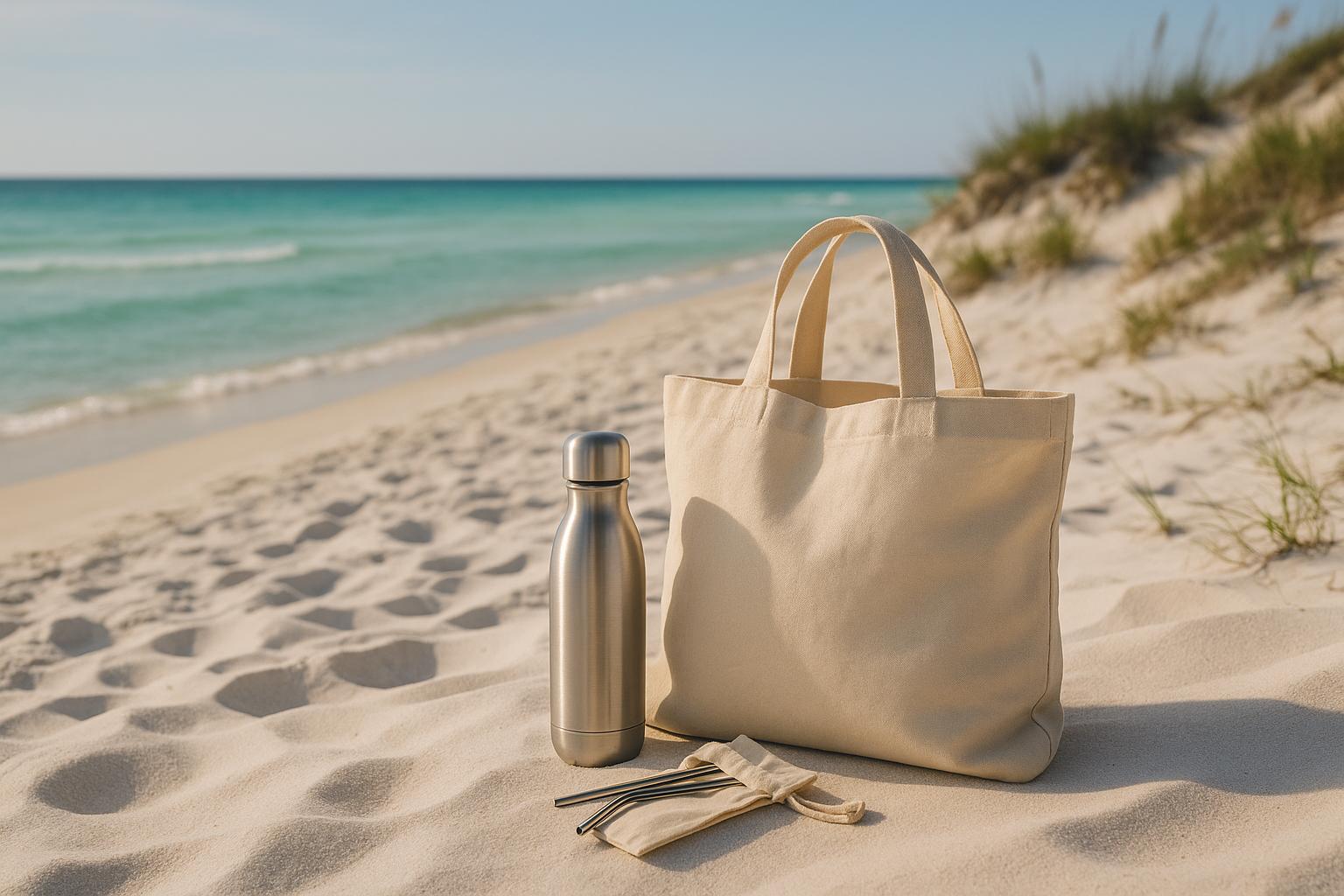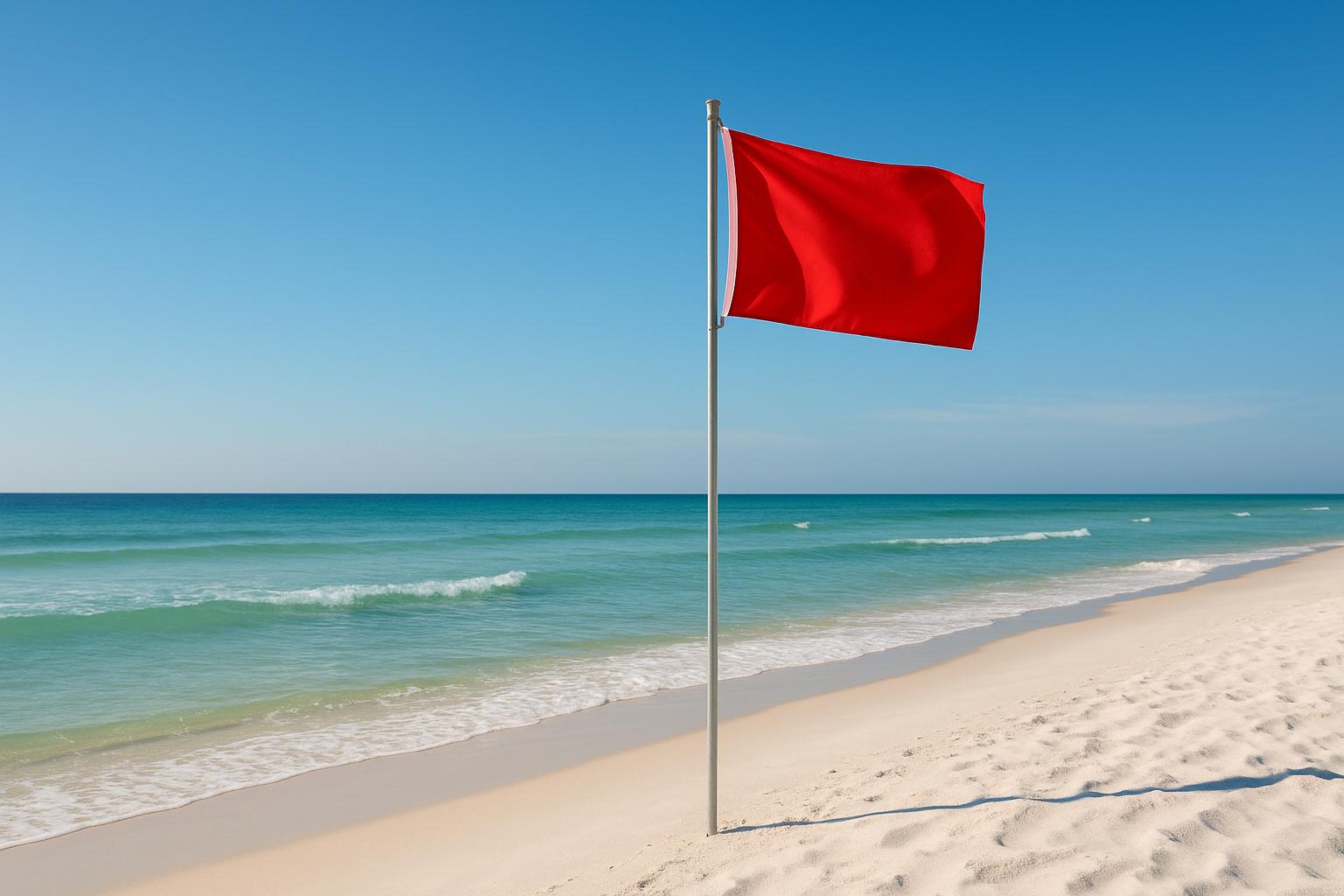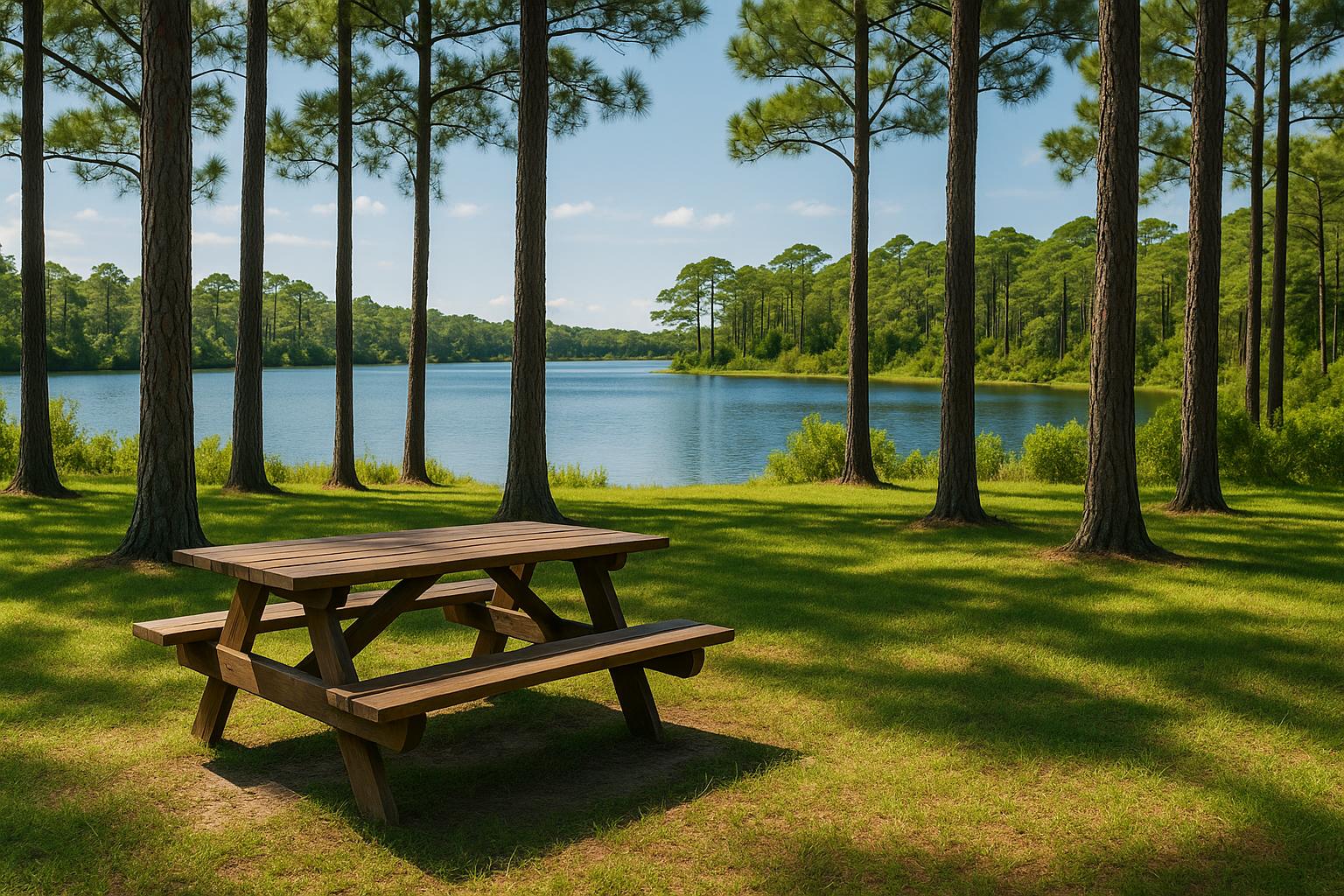South Walton Turtle Watch (SWTW) is a non-profit organization dedicated to protecting sea turtles along Walton County beaches. Their work includes monitoring nests, rescuing stranded turtles, and educating the public about conservation. Volunteers patrol 23 miles of coastline daily during nesting season (May 1–October 31), tracking nests, marking them, and ensuring hatchlings safely reach the ocean. Key challenges include artificial lighting, habitat loss, and climate change, which threaten turtle populations.
Key Takeaways:
- Nesting Season: May 1–October 31.
- Main Species: Loggerhead and Green Sea Turtles.
- Volunteer Work: Daily patrols, nest monitoring, and public outreach.
- Threats: Lighting, predators, pollution, and storms.
- How to Help: Follow the #CleanDarkFlat rules - keep beaches clean, reduce lighting, and flatten sand structures.
To report turtle sightings or issues, call the SWTW Hotline at 850-865-4503. Community involvement is critical to ensuring the survival of these keystone species.
Daily Work and Volunteer Support
Main Activities of the Turtle Watch Team
The South Walton Turtle Watch (SWTW) team hits the beaches before sunrise, covering 23 miles of monitored coastline. During these early patrols, volunteers search for fresh sea turtle tracks, working quickly to spot them before they’re disturbed by beachgoers or the elements. When tracks are found, the team identifies the species, marks the nest with stakes and tape, and logs its exact location using GPS coordinates.
The team consists of 25 walkers with permits, supported by another 35–40 volunteers who help patrol and document findings. Throughout the nesting season, which runs from May 1 to October 31, volunteers keep a close eye on both new and existing nests. They monitor for disturbances, signs of predators, or early hatching activity. They also record "false crawls", where turtles come ashore but don’t nest, offering valuable insights into the challenges these turtles face. After hatchlings emerge, volunteers excavate the nests to count eggshells, release any remaining hatchlings, and calculate hatching success rates, which they report to the Florida Fish & Wildlife Conservation Commission (FWC). In emergencies, FWC-permitted team members handle direct interactions with turtles, while volunteers assist with logistics and data collection. These detailed efforts are at the heart of SWTW’s mission to protect South Walton’s sea turtles.
What Volunteers Do
Volunteers play a vital role in every aspect of SWTW’s work, from patrol duties to outreach and emergency support. While only certified and FWC-permitted members can directly handle turtles or nests, volunteers receive training in species identification, nest marking, safety protocols, and reporting. A typical day for volunteers starts before dawn, as they patrol assigned sections of the beach, searching for tracks and new nests. They document their findings and report them to area coordinators. Volunteers also monitor existing nests for disturbances or hatching activity and assist with nest excavations after hatchlings emerge.
In addition to patrols, volunteers help spread awareness about sea turtle conservation. They engage with beach visitors, hand out educational materials, and participate in community events to promote SWTW’s mission. The work isn’t always easy - volunteers face early mornings, unpredictable weather, and occasional disruptions from beachgoers - but teamwork, thorough training, and a shared passion for conservation keep them going. When stranded or injured turtles are reported, volunteers play a crucial role in immediate data collection, enabling quick action and strengthening ties with the local community.
The Friends of South Walton Sea Turtles, a partner organization, focuses on education and outreach, supporting SWTW by attending events, visiting schools, and hosting community meetings. If you’re interested in joining the team, you can learn more about training sessions and volunteer opportunities by visiting SWTW’s website or checking their social media channels.
Challenges in Sea Turtle Conservation
Threats to Sea Turtles and Their Homes
Even with the tireless work of volunteers, protecting sea turtles remains an uphill battle. In South Walton, these turtles face a mix of natural and human-made threats. Artificial lighting - whether from beachfront properties, vehicles, or flashlights - confuses both nesting females and hatchlings. Instead of heading toward the ocean, they often move inland, putting them at risk of dehydration, predators, or even being hit by cars. Beach debris is another issue, as it can trap turtles or block access to nesting sites. On top of that, predators like raccoons, foxes, and ghost crabs dig up nests, reducing the chances of hatchlings surviving. Severe weather events, such as hurricanes, can destroy numerous nests in one sweep, while human activities further complicate conservation efforts.
How Development and Climate Affect Turtles
The rapid pace of coastal development along South Walton and the 30A corridor is shrinking the space available for turtles to nest. Artificial lighting, physical barriers, and other disturbances make it harder for turtles to return to their traditional nesting spots. Climate change adds another layer of difficulty. Rising sea levels and more frequent storms can flood nests or erode beaches, while higher sand temperatures impact hatchling sex ratios, often producing more females than males. For instance, a major storm during nesting season once wiped out several nests, and an uptick in false crawls was directly linked to increased beachfront lighting. This led to community outreach campaigns and stricter enforcement of lighting regulations. Every season, these challenges are evident in the data collected by conservation teams.
Current Conservation Numbers
Conservation teams meticulously track data throughout the season, recording nest counts, hatching success rates, and false crawls - cases where turtles come ashore but don’t nest. This information is then submitted to the Florida Fish & Wildlife Conservation Commission to aid in shaping broader conservation strategies. Unfortunately, the numbers highlight ongoing declines in sea turtle populations, driven by habitat destruction, pollution, entanglement in fishing gear, vessel strikes, and poaching. Each successful nest is a small but crucial victory, especially since sea turtles are protected under the Endangered Species Act. As a keystone species, sea turtles reflect the health of beach and ocean ecosystems, making their protection not just important for them but for the environment as a whole.
Sea Turtle Conservation in Florida is Hard
sbb-itb-d06eda6
How the Community Can Help
The dedicated volunteers of South Walton Turtle Watch (SWTW) have laid a strong foundation for sea turtle conservation, but preserving these incredible creatures is a community effort. Everyone in South Walton can contribute by following simple steps and staying informed about ongoing initiatives.
#CleanDarkFlat Rules
The #CleanDarkFlat campaign outlines three straightforward rules to protect nesting and hatching sea turtles during the critical nesting season, which runs from May 1 to October 31.
- Clean: At the end of each day, remove all trash and personal items like beach chairs, umbrellas, and toys. These objects can block turtles from reaching their nesting sites or prevent hatchlings from making it to the ocean. Even small items left behind can create obstacles for these vulnerable creatures.
- Dark: Reduce artificial lighting, which can confuse both nesting females and hatchlings. Use red or amber lights, turn off porch lights near the beach, and close curtains during nesting season to minimize light pollution.
- Flat: Before leaving the beach, fill in any holes and flatten sandcastles. These simple actions prevent hatchlings from becoming trapped or exhausted as they make their way to the water.
Property owners and vacation rental managers can make a big difference by installing turtle-friendly lighting, educating guests about these guidelines, and ensuring outdoor lights are either turned off or properly shielded during nesting season.
How to Report Turtle Sightings and Problems
If you come across sea turtles, injured animals, or disturbed nests, it’s important to avoid handling them. Sea turtles are protected under federal law, and only trained and permitted responders are authorized to interact with them.
Instead, report any sightings or issues to the appropriate authorities. For immediate assistance, call the South Walton Turtle Watch Sea Turtle Hotline at 850-865-4503. This hotline connects you with local experts who can respond to emergencies. In urgent cases, you can also contact the Walton County Sheriff at 850-892-8111 or reach the Florida Fish & Wildlife Conservation Commission by dialing *FWC or #FWC from your cell phone.
These systems ensure that trained professionals can assess the situation and, when necessary, transport injured turtles to licensed rehabilitation facilities. Beyond reporting, raising awareness within the community strengthens conservation efforts.
Education Programs and Events
While reporting turtle-related issues is vital, participating in educational initiatives can create a lasting impact. South Walton offers various programs designed to deepen understanding and encourage active involvement in conservation.
Programs like Wild Sea Turtle Wednesdays provide interactive sessions where residents and visitors can meet conservation experts and engage in hands-on activities. These events often include presentations about turtle biology, discussions on the challenges they face, and practical advice for protecting nesting sites.
Throughout the year, volunteers and organizations visit schools, libraries, and community events to spread awareness. Families can join beach cleanups or attend workshops where kids learn about sea turtles through fun, age-appropriate activities. Some programs even allow children to become "junior turtle ambassadors", empowering them to share conservation messages with friends and family.
Social media platforms and community events also play a key role in expanding public awareness. Websites like sowal.co share timely updates on nesting season, volunteer opportunities, and upcoming events, helping both locals and visitors along the 30A coastline stay informed.
Collaborative efforts between groups like South Walton Turtle Watch and Friends of South Walton Sea Turtles have further amplified these educational initiatives, creating more opportunities for people to get involved and make a difference.
Partnerships and Community Impact
Conservation efforts flourish when organizations join forces, creating a network of support that extends beyond individual initiatives.
Working with Local Groups
In South Walton, partnerships play a key role in conservation efforts. South Walton Turtle Watch collaborates with state and local agencies to amplify its impact. The Florida Department of Environmental Protection offers essential regulatory guidance, ensuring all conservation activities align with state laws. This guidance forms the legal backbone for protecting sea turtles along the region’s beaches.
Local law enforcement also contributes by enforcing lighting ordinances and preventing disturbances to nests. Their authority is crucial when violations occur or urgent intervention is needed, safeguarding these federally protected species.
Another vital partnership is with Friends of South Walton Sea Turtles, which complements the fieldwork of South Walton Turtle Watch. While the latter focuses on daily monitoring, Friends of South Walton Sea Turtles takes the lead on education and fundraising efforts. Together, they run public awareness campaigns, school programs, and beach clean-ups, engaging both residents and visitors in conservation work.
This teamwork has delivered tangible results. Daily monitoring now covers all Walton County beaches during nesting season, leading to more nests being protected and data collected on hatchling success. These efforts have directly contributed to higher survival rates, as documented in annual reports.
How Digital Platforms Help Conservation
Beyond local partnerships, digital platforms have become powerful tools for spreading conservation messages. sowal.co plays a pivotal role by sharing updates about nesting seasons, conservation guidelines, and volunteer opportunities along the 30A coastline.
The platform’s influence goes beyond information sharing. By promoting eco-friendly practices and featuring local conservation events, it educates tourists who might otherwise miss these messages, especially during peak tourist seasons when beach activity is at its highest.
Social media has also revolutionized public engagement. Friends of South Walton Sea Turtles uses platforms like Facebook, Twitter, and Instagram to share tips on protecting turtles, announce events, and celebrate successes. This approach reaches a far larger audience than traditional methods ever could.
Another innovative tool is the Beach Access Alert System, which divides the coastline into 18 zones, each with a unique alert code. This system allows conservation teams and beach vendors to coordinate efficiently, ensuring that equipment is only set up after turtle surveys are complete. This minimizes disturbances to nests and hatchlings through precise digital communication.
Awards and Recognition for Conservation Work
The success of these collaborative efforts hasn’t gone unnoticed. In 2000, South Walton Turtle Watch was named Conservation Group of the Year by the Florida Wildlife Federation, a testament to their dedication to sea turtle protection and the power of their partnership-driven approach.
Local recognition has also poured in, celebrating the group’s contributions to environmental stewardship and community education. These accolades underscore the effectiveness of bringing together government agencies, non-profits, volunteers, and digital platforms.
Beyond formal awards, the collaboration between South Walton Turtle Watch, Friends of South Walton Sea Turtles, and local agencies has become a model for effective community conservation. This reputation has attracted new partnerships and resources, creating a cycle of growth that continues to strengthen their efforts.
Feedback from the community - residents, tourists, and environmental groups alike - consistently highlights the positive impact of these partnerships. Their coordinated approach is widely recognized as a cornerstone of the region’s conservation success. It’s a powerful reminder of how collective effort can protect our coastal wildlife for generations to come.
Conclusion
The efforts of South Walton Turtle Watch highlight how committed conservation initiatives can truly make a difference for endangered species. Their work emphasizes the importance of community involvement in protecting sea turtles - vital creatures that serve as keystone species, reflecting the health of our oceans and beach ecosystems. By safeguarding these turtles, we also help preserve the coastal environment that makes South Walton a cherished place to call home or visit.
Community participation is at the heart of successful turtle conservation. Simple actions like following the #CleanDarkFlat guidelines - keeping beaches free of trash, using red or amber lights at night, and filling in sand holes - directly impact turtle survival. Residents and visitors who report turtle sightings or issues to local authorities play an active role in the broader conservation network along the 30A coastline.
While there have been notable achievements, challenges remain. Sea turtles continue to face threats such as habitat loss, pollution, entanglement in fishing gear, and the effects of climate change. Even so, the collaborative efforts of South Walton Turtle Watch, Friends of South Walton Sea Turtles, state agencies, and community members offer a powerful example of how teamwork can drive effective conservation.
Digital platforms like sowal.co have further expanded these efforts, sharing vital conservation messages with tourists who might otherwise overlook the importance of protecting nesting turtles. By combining on-the-ground monitoring with community education and online outreach, conservation efforts successfully engage both long-term residents and first-time visitors during the busy nesting season, which runs from May through October.
Looking ahead, the continued success of sea turtle conservation in South Walton depends on ongoing community involvement. Whether it’s volunteering for beach surveys, attending educational events, or simply adhering to protective guidelines, every action counts. In 2024 alone, these collective efforts helped 3,845 hatchlings emerge from 70 protected nests along Walton County’s beaches. These numbers are a testament to the power of community action - proof that when people come together for conservation, they can make a lasting impact.
FAQs
How can I volunteer with the South Walton Turtle Watch?
Volunteering with the South Walton Turtle Watch offers a meaningful way to contribute to the protection of local wildlife, especially endangered sea turtles. If you're interested in helping out, contact the organization directly to explore their volunteer opportunities. Typical activities include monitoring turtle nests, educating the community about conservation efforts, and providing assistance during the hatchling season.
It’s worth noting that some training might be necessary, as safeguarding sea turtles requires adhering to specific protocols to ensure their well-being. By volunteering, you’ll become part of an effort to preserve South Walton’s natural environment and its incredible wildlife for future generations.
What are the biggest threats to sea turtles in South Walton, and how can we help protect them?
Sea turtles in South Walton face numerous challenges. Coastal development has led to habitat loss, while artificial lighting near the shore can confuse hatchlings, steering them away from the ocean. Human activities, like littering and leaving beach furniture or other obstacles behind, add to the problem. On top of that, natural predators and the effects of climate change further threaten their survival.
You can play a part in protecting these amazing animals with a few simple steps. Turn off or shield any lights visible from the beach to prevent disorienting hatchlings. Make it a habit to remove beach furniture and other items at night, keeping nesting areas clear. Be mindful not to disturb nests or hatchlings, and always dispose of trash properly to keep their environment clean. Cutting back on plastic use also helps reduce pollution in their habitats. When the community works together, it can make a big difference in ensuring sea turtles continue to thrive for years to come.
Why is it important to follow the #CleanDarkFlat guidelines during sea turtle nesting season?
Protecting sea turtles and their hatchlings during nesting season is easier than you might think. The #CleanDarkFlat guidelines offer simple yet effective ways to reduce disturbances and create a safer environment for these incredible creatures.
- Clean: At the end of the day, clear the beach of furniture, trash, and other obstacles. These items can block turtles' paths or even trap them.
- Dark: Keep artificial lights near the beach to a minimum. Bright lights can confuse turtles and hatchlings, leading them away from the ocean instead of toward it.
- Flat: Smooth out sandcastles and fill in any holes. Uneven sand can injure turtles or prevent them from reaching their destination.
By taking these small actions, you're helping to protect South Walton's sea turtles and ensuring their habitat remains a safe place for future generations.



